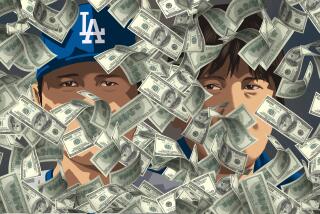The pot has never been bigger -- or more respectable
- Share via
On a recent weekday afternoon in Bel-Air, Phil Hellmuth cozied up to a green felt card table piled with $18,000 in $100 bills. Hellmuth, the 1989 World Series of Poker champion, was shooting an infomercial for his “million dollar” poker system video, which promises to teach the ordinary chump to play like a champion. If anyone has an inside track on poker, it’s Hellmuth, the winner of $3.5 million in tournament play, and the author of last year’s book “Play Poker Like the Pros” (HarperCollins).
A poker champ showing his hand to the public? If this has anything to tell us, it’s one more piece of evidence that poker has hit the tipping point, the apex of the cultural bubble -- that its time has come.
Poker can be found on television most any night of the week and on the Internet any hour of the day. It’s making the bestseller lists, drawing crowds to casinos and, more than ever, it’s the impetus for home parties, where friends gather, drawn by the camaraderie of the table and the opportunity to walk away with a bit of spare change.
It’s popping up in fashion magazines -- W just weighed in on the Gourmet Poker Club, a high-stakes Hollywood game featuring such heavyweight players as Steve Martin, Johnny Carson and Barry Diller. And opposite Super Bowl festivities -- last Sunday’s “World Poker Tour Battle of Champions” on NBC drew more than 3 million viewers, the largest viewing audience of any poker contest in history.
What’s the appeal? Partly, of course, it’s the sense of risk, of backroom chic, the idea that only an activity that seems a bit disreputable can really be any fun. “It’s always been a game that’s slightly sexy, with a degenerate undertone,” says Andy Bellin, a semipro player whose book, “Poker Nation” (HarperCollins, 2002), is a lively look at professional poker.
In the last few years, however, poker has made inroads into respectability -- helped, no doubt, by the Travel Channel’s “World Poker Tour” and Bravo’s “Celebrity Poker Showdown,” where actors like Paul Rudd and Ben Affleck go up against each other for charity. “Any time you can see celebrities doing things that you do,” says actor Kevin Pollak, who hosts the Bravo show, “it’s a win-win. We’ve never been able to see them quite like this.”
Their numbers prove this out. According to the Nielsen rankings, Pollak’s show brings in an average of 376,000 viewers, making it Bravo’s fourth-highest-rated show. The “World Poker Tour” and its “Hollywood Home Game” celebrity spinoff are the Travel Channel’s top-rated shows at 737,000 and 893,000 viewers, respectively.
Then there’s the Internet, which has made the game available to players who might be reluctant to set foot inside a poker hall. “It might be scary to walk into a card room for the first time,” says Phyllis Caro, director of poker operations at Hollywood Park, “but all of a sudden people are playing on their computers and getting used to it.”
Literary efforts, too, have brought poker into the mainstream, from the new “Read ‘Em and Weep” (HarperCollins), an anthology of poker-related stories, poems and essays featuring work by Nelson Algren, Bertolt Brecht and Billy Collins, to Bellin’s “Poker Nation” and last year’s “Poker Face” (Crown), a memoir by poet Katy Lederer, whose siblings are world-class players on the poker tour.
The most noteworthy may be James McManus’ “Positively Fifth Street,” (Farrar, Straus and Giroux), a bestselling account of the author’s unlikely success at the 2000 World Series of Poker; he came in fifth and won nearly a quarter of a million dollars, or about 62 times what Harper’s paid him to cover the event. (Though his assignment was to write about the event, he entered it using his advance from the magazine.)
This sea change in poker’s image has also come about, in part, because of a shift in the game itself. “It’s the great American card game,” says Steve Lipscomb, creator of “World Poker Tour,” a series of tournaments featuring many of the finest players in the world. “What jazz is to music, poker is to cards.” Indeed, Mark Twain wrote about it, as did Damon Runyon. Certainly, poker was the signature pastime of the Wild West, where the game earned its rough-around-the- edges, outlaw mystique. Think Wild Bill Hickok, who was shot in the back of the head while playing a hand. Such a reputation has carried over; consider Benny Binion, who founded the World Series of Poker in 1970. He only set up shop in Las Vegas to escape retribution for a murder he had allegedly masterminded in Dallas.
Lately, explains Caro, the game’s focus shifted from ring, or live-action, games, “where you buy in and win or lose as much as you want,” to tournaments, which feature a buy-in from $50 to $25,000 and last until one player is left. Poker’s outlaw cachet is hard to maintain in tournament play, McManus says.
“A high-stakes tournament is mostly well-behaved men and women sipping mineral water,” he says. “You can’t smoke and there’s no profanity or you get suspended for 20 minutes. It’s a middle-class, respectable game now.”
If you want to understand the roots of this development, McManus points to poker’s expansion throughout Southern California in the 1980s, after card club owners challenged an archaic 19th century statute and essentially legalized stud poker and Texas Hold’em in the state. That opened up the game to everyone.
“Southern California was ground zero,” says McManus. “Before poker became common there, you needed to be a tough character.
The hardest part of the game used to be getting your winnings home. Whereas today, everybody has a chance.”
The idea that this is a game for everyone is a constant refrain in the poker community, an explanation for its broad appeal. It’s not a bad theory, since at a poker table all players are ostensibly equal, although the
truth is there’s a lot of skill involved.
“There are three Ps in poker: people, patience and position,” notes David James, a 40-year-old executive headhunter and professional poker player who describes himself as “a real rounder, somebody who finds a soft spot in his opponent and takes advantage.”
Poker is less a game of chance than of human nature, in which it’s as important to read the other players as to read your cards. Even the sharpest players, though, are affected by the luck of the draw, especially in a tournament, where a talented amateur can win a lot of money.
In 2003, the aptly named Chris Moneymaker, a 27-year-old Tennessee accountant, parlayed a victory in a $40 online tournament into a seat at the world series, where he won the $2.5-million championship. Moneymaker has become the poster child for the possibilities of tournament poker. (“The greatest advertising gimmick in the history of gaming,” Pollak says.)
“The most interesting thing in poker right now,” McManus says, “is that it’s a functional democracy. On paper, anyway, everyone has an equal shot. That doesn’t happen in golf or football. You can’t play one on one against Michael Jordan. But in a poker tournament, you can play the top professionals. And with the right combination of luck and talent, you can win.”
Combine this “functional democracy” with those most democratic of media, TV and the Internet, which have insinuated poker much more deeply into people’s lives, and a wave of interest is born. This is especially true when it comes to “World Poker Tour,” which, with a variety of innovations, has added some much-needed tension to the game.
Before the tour’s debut last March, poker on television was a losing bet. ESPN had the “World Series of Poker,” but even a devoted aficionado like McManus says it was “like watching bears hibernate.” The difference with “World Poker Tour” was simply putting a camera on the players’ hole -- or face-down -- cards.
Allowing the audience to see the hole cards has, in the words of “Read ‘Em and Weep” editor John Stravinsky, “introduced a cinematic convention. It’s like a movie. You know what’s going to happen, but the players don’t. You’re squirming in your seat.”
“World Poker Tour,” says Bellin, “has everything -- gambling, psychological warfare, action -- that makes TV compelling. You watch great players face off against each other, but the key is that you see how they play their hands.”
Lipscomb is even more explicit. “What we’re doing,” he says, “is making people feel like insiders. We’re educating the 50 or 60 million people who play recreationally.”
Fifty million people is a vast market, so much so that on Sunday, NBC became the first network to broadcast poker when it put the “World Poker Tour Battle of Champions” against the Super Bowl pregame show. “Super Bowl Sunday is like an American holiday,” says Jon Miller, senior vice president of programming at NBC Sports. “And we want to make this part of the mix.”
What remains to be seen is whether poker can maintain its momentum, if it has the requisite pop culture staying power. Yes, as Bellin notes, poker may have “lost some of its salacious veneer,” but in the end, it’s still a game where elemental issues are at stake.
“Once,” recalls Stravinsky, “I played in a game where we caught a guy cheating. His hands were shaking. Our hands were shaking. We were all embarrassed and upset.” A century ago, such a cheater might have met the same fate as Wild Bill Hickok, but here, he was barred from the game.
“I still remember,” Stravinsky says, “the drama inherent in that moment. It’s just an anecdote from my poker history, but it stays with me all the same.”



